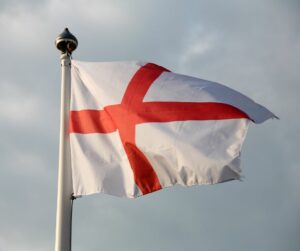

X
This site uses cookies. By continuing to use this site you agree to our use of cookies. To find out more, see our Privacy Policy and Cookie Policy.

On 23rd April, England honours its patron saint, St George, on his feast day. The iconic St George’s Cross flag, the flag of England, takes centre stage.
April 23rd is a day dedicated to celebrating the life and legacy of England’s patron saint, St George. The story goes that the town of Silene (in modern day Libya) was captured by a dragon. Each day the locals offered it a human sacrifice. One day a knight, St George, was visiting the town. He killed the dragon to save the people of Silene. To show their gratitude, the townsfolk converted to Christianity. Since he died in 303AD, St George has been celebrated on the anniversary of his death.
The celebrations around St. George’s Day were once on a par with Christmas festivities. But towards the end of the 18th century when England unified with Scotland, the importance dwindled. St. George is also celebrated in other countries. He is the patron saint not just of England, but of Georgia too.
St George’s symbol is a red cross over a white background. This is the same as the cross incorporated into the English flag. His emblem was brought to England by Richard the Lionheart in the 12th century. It was worn by the king’s soldiers in battles. The red and white of the flag serve as a powerful symbol of English identity, pride, and unity. It represents the nation’s history, values, and sense of belonging.

The red cross on a white background of the St George’s Cross flag is steeped in symbolism. The red represents courage, sacrifice, and the blood shed in defense of England. The white signifies purity, peace, and the enduring spirit of the English people.